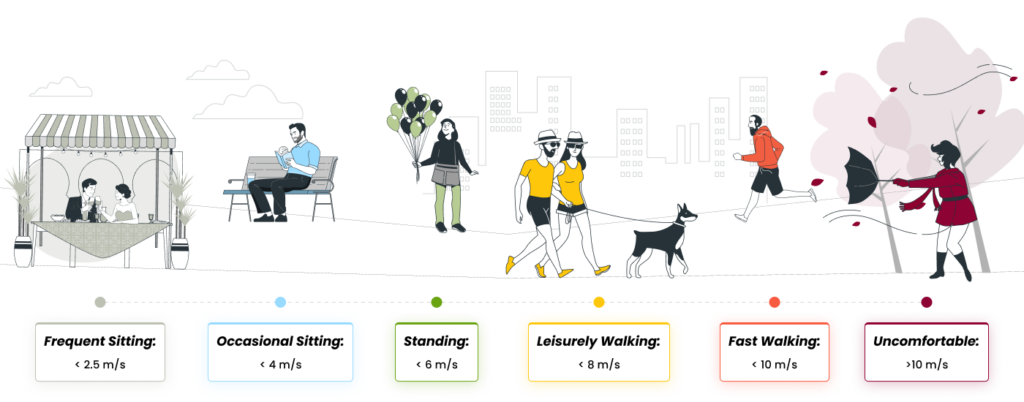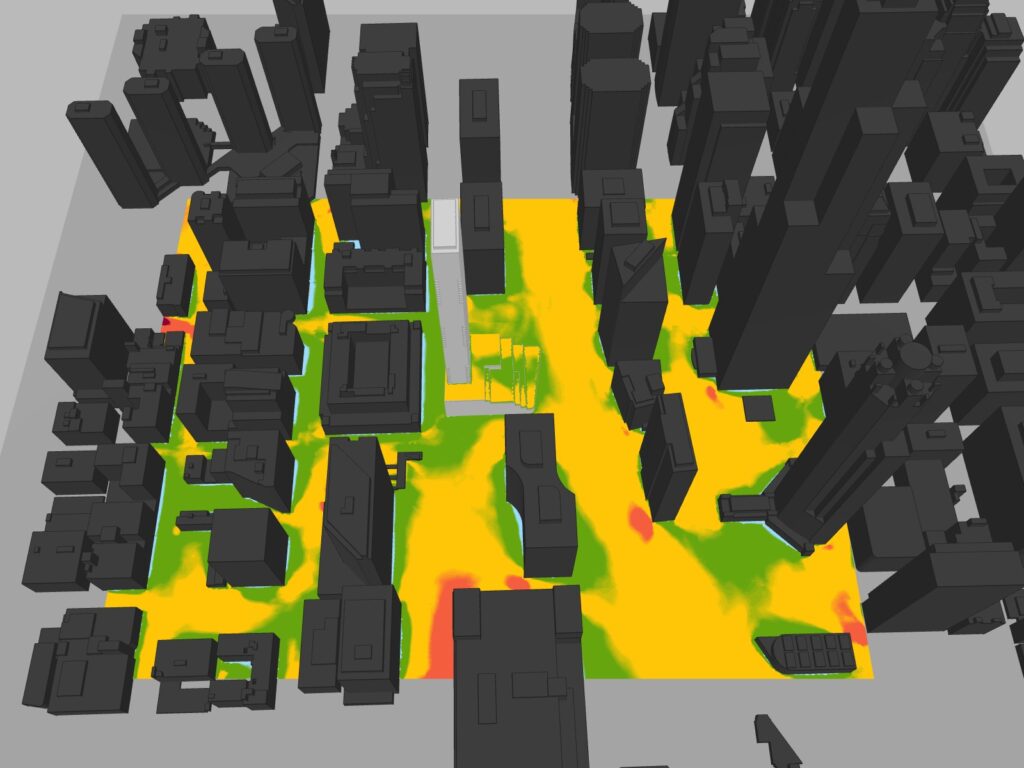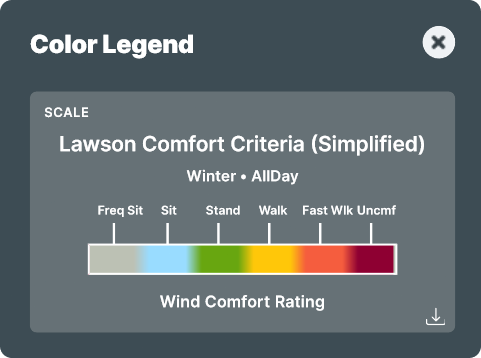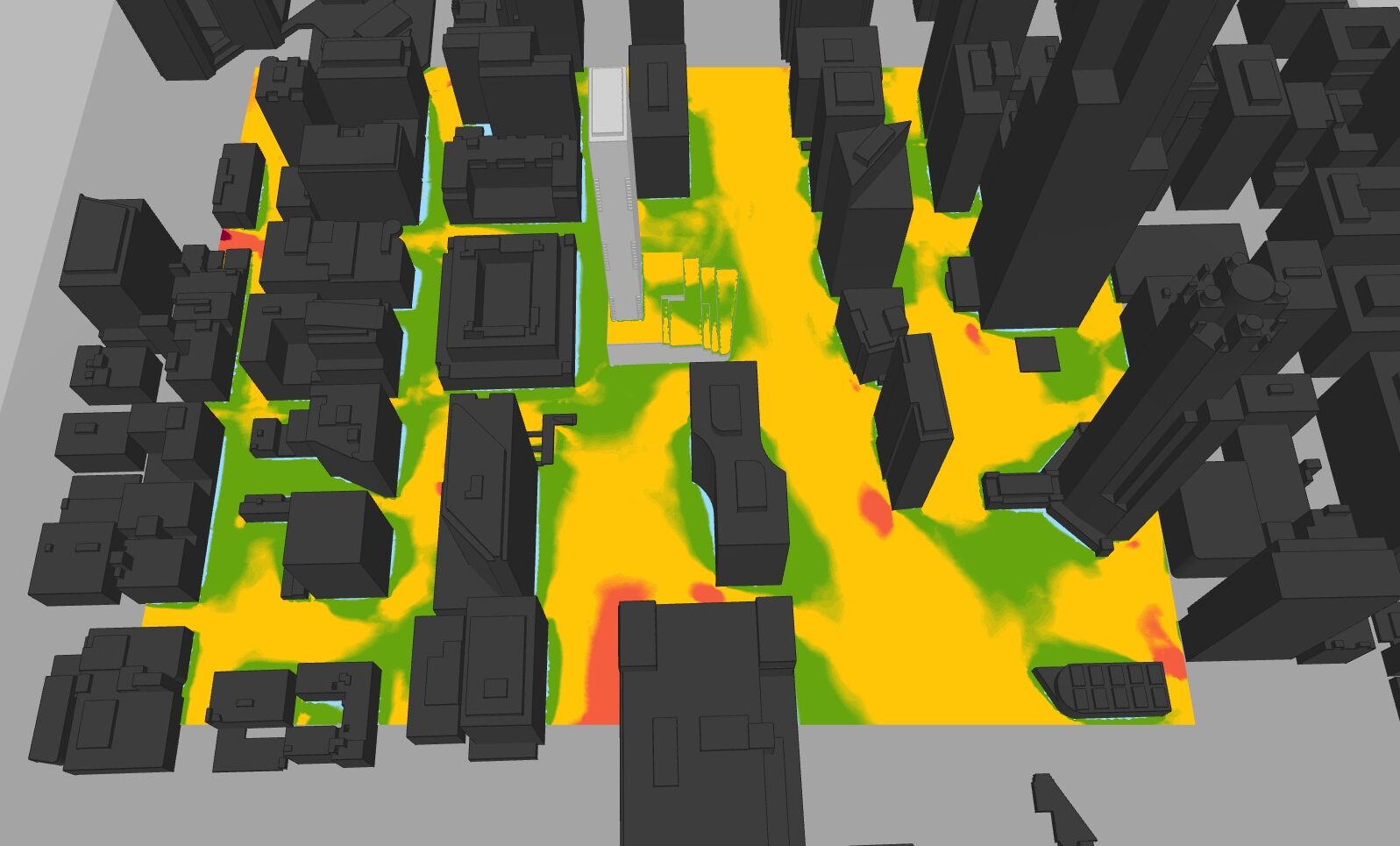Understanding and optimizing the microclimate around buildings becomes paramount as we step into a new era of sustainable and climate-conscious design. But how do we measure something as subjective as wind comfort?
At its core, wind comfort is evaluated based on how individuals perceive wind conditions while engaging in different activities. This evaluation relies heavily on numerical data, particularly local wind speeds either gathered from weather stations or manually modelled. By leveraging this data along with established wind comfort criteria, urban planners can gauge the likelihood of wind speeds exceeding predetermined thresholds.
In this article, we’ll zoom in on the Lawson wind comfort criteria, which is one of the many wind comfort standards accepted globally and is now a new Orbital Stack feature. We will delve into its nuances and explore the various denominations it encompasses to cater to diverse threshold wind speeds.
Decoding the Lawson Pedestrian Wind Criteria
Developed by T.V. Lawson at Bristol University, UK, the Lawson Pedestrian Wind Criteria is a globally accepted standard for evaluating wind impacts on pedestrian safety and comfort. These criteria, rooted in extensive research, serve as the benchmark against which the wind microclimate around buildings is assessed.
The fundamental principle driving this assessment is the acknowledgment that wind conditions should align with the intended activities in a given area. This knowledge creates opportunities for urban designers to work with the environment to create spaces that can be enjoyed for longer periods of time.

Categorizing Wind Comfort
The Lawson Criteria seeks to classify different areas based on the activities pedestrians engage in and their expected tolerance to predicted wind conditions. It recognizes that pedestrians, depending on their activities, will feel comfortable being exposed to different wind strengths.
For instance, a runner might tolerate or even enjoy a moderate breeze to keep cool, while diners savoring a meal on a patio could find those same winds disruptive to their dining experience if their napkins must be held down but their glassware to remain on the table.
The Gust Equivalent Mean (GEM)
Central to the Lawson Criteria is the Gust Equivalent Mean (GEM), an adjusted wind speed derived from the analysis of average hourly wind speeds (steady-state) and wind gusts (spontaneous). These speeds are calculated considering all 24 hours of the day across all four seasons. The resulting GEM serves as a crucial metric for understanding and predicting wind impacts.
In the table below, we’ll explore the five different Lawson Wind Comfort Criteria in order of most calm wind conditions to windiest.
| Activity | Description | GEM Speed (mph) | GEM Speed (kph) | GEM Speed (m/s) | LDDC Lawson Category | City Lawson Criteria Category |
| Frequent Sitting | Little to no breeze. Acceptable for frequent outdoor sitting use such as a restaurant or café patio. | ≤ 5.5 | ≤ 9 | ≤ 2.5 | Sitting | Frequent Sitting |
| Occasional Sitting | Calm or light breezes. Acceptable for occasional outdoor seating, such as public outdoor spaces, balconies and terraces intended for occasional use. | ≤ 9 | ≤ 14.5 | ≤ 4 | Sitting | Occassional Sitting |
| Standing | Gentle breezes. Acceptable for building entrances, bus stops, and other places where pedestrians may linger. | ≤ 13.5 | ≤ 21.5 | ≤ 6 | Standing | Standing |
| Leisurely Walking | Moderate winds. Acceptable for window shopping or leisurely strolls across a park or plaza. | ≤ 18 | ≤ 29 | ≤ 8 | Leisurely Walking | Walking |
| Fast Walking | Relatively strong winds. Tolerable for brisk walking, jogging or cycling. | ≤ 22 | ≤ 36 | ≤ 10 | Uncomfortable | Uncomfortable |
| Uncomfortable | Too windy for any normal pedestrian activities. A more in-depth wind analysis study might be necessary. | > 22 | > 36 | > 10 | Uncomfortable | Uncomfortable |
Analysis Criteria – Supplemental Information
- Hours of the Day: All
- Seasons: All
- Allowed Exceedance (Comfort): 5%
- Allowed Exceedance (Safety): 0.022%
Why Use Lawson Wind Comfort Criteria?
When it comes to good urban design, the importance of considering the local wind environment cannot be overstated. Understanding how wind interacts with the landscape and built structures is crucial for making informed design decisions. The impacts of these decisions can be far-reaching, economically advantageous, and value-driving for clients and end-users alike.

1. Enhancing Pedestrian Safety
The Lawson Wind Comfort Criteria holds immense significance in promoting pedestrian safety. By establishing clear thresholds for wind conditions, architects and developers can create spaces that occupants and pedestrians can navigate safely without the risk of being adversely affected by strong winds or gusts.
It should be noted that that using Lawson Wind Comfort Criteria when designing outdoor spaces does not mean you should anticipate or design for the total elimination of wind gusts. It simply means you can work with the local microclimate to create spaces in a more effective, safe way.
If the predicted wind speeds within your development do not match the intended usage of the space or are shown as uncomfortable, further wind analysis should be conducted with a wind consultant.
2. Tailoring Design for Activities
Understanding that different activities warrant different wind conditions is pivotal in crafting spaces that cater to diverse user experiences. The Lawson Criteria enables architects and developers to tailor their designs to specific activities, ensuring that each space is optimized for the intended purpose.
Each climate will have its challenges, and each outdoor space its own unique needs. When considering outdoor space in generally warmer climates, using wind as an advantage to create natural ventilation creates a more sustainable, enjoyable space for occupants.
No two spaces are alike, and both will have their own intended purpose, so why not make design choices early on that allow for better use of the space?
3. Accurate Understanding and Prediction
By considering both steady-state winds and spontaneous gusts across all seasons, the Lawson Criteria provides a nuanced understanding of the wind microclimate, allowing for more accurate predictions and better-informed design decisions.
Combining these criteria with other key metrics included in a tool like Orbital Stack, such as outdoor thermal comfort potential and cladding wind load pressures on facades allow for a more precise understanding of how a building and it’s surroundings will behave when subjected to decades of environmental factors.
Leveraging Lawson Criteria with Orbital Stack
Orbital Stack has now seamlessly integrated the Lawson Wind Comfort Criteria into both its AI and CFD web-based wind analyses for all monthly subscribers. This integration empowers architects and developers to go beyond conventional wind analysis with a simple tool that aligns with global standards for pedestrian comfort.
User-Friendly Interface
Orbital Stack’s user-friendly interface ensures that leveraging the Lawson Criteria is both intuitive and efficient. Users can input project data and visualize wind conditions with overlays and streamlines, gaining immediate insights into how design choices impact pedestrian comfort.

A clear and distinctive colour scale allows for easy visual representation of each comfort category, allowing you to both understand and explain how the microclimate impacts will be affected by various design choices. Compare a multitude of design options in minutes, identifying potential wind-related issues and making informed choices that align with the desired pedestrian experience.
Whether it’s ensuring comfortable outdoor seating areas, walkable public spaces, or safe pedestrian zones, this feature contributes to the creation of high-performance and resilient projects.
Conclusion
This feature stands as a testament to our commitment to providing cutting-edge tools that empower architects, engineers, and developers to create spaces that not only captivate aesthetically but also prioritize the safety and comfort of pedestrians.
With Orbital Stack’s integration of this globally recognized standard, we invite you to embark on a journey of innovation, ensuring that the spaces we create are not just visually stunning but also inherently functional and safe.
Embrace the future of urban design with Orbital Stack and the Lawson Wind Comfort Criteria – where each gust of wind is a stroke of inspiration in crafting the cities of tomorrow.
